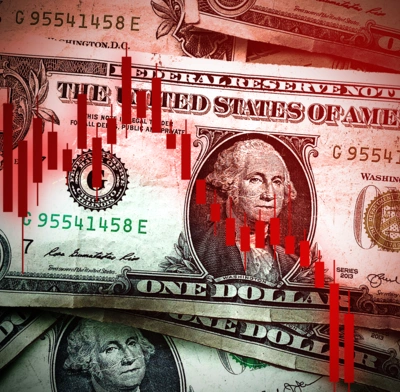The US Dollar has posted its weakest first-half performance since 1973. The Dollar Index (DXY) dropped 12% in the first six months of 2025, raising fresh questions about investor confidence in the greenback. Meanwhile, Bitcoin (BTC) surged more than 30%, reviving a familiar narrative: when the dollar breaks down, Bitcoin breaks out.
Dollar’s Worst First Half in 50 Years – Will History Repeat for Bitcoin?

How the dollar shapes Bitcoin sentiment
At the beginning of the month, the DXY closed at 96.7 – down sharply from the start of the year and at its lowest level since early 2022. The index now sits 7.3 points below the 200-day moving average of 104.0 – its largest deviation in over two decades.
The DXY tracks the dollar’s strength relative to a basket of major currencies, primarily the euro (58%), yen (14%), and pound (12%). It’s often seen as a proxy for global risk sentiment. A rising DXY reflects investor caution and preference for safe-haven assets like cash or treasuries. A falling DXY implies a shift toward riskier assets – equities, commodities, or crypto.
When the dollar weakens, capital often rotates into alternative stores of value. Traditionally that’s meant gold, foreign sovereign debt, or currencies like the Swiss franc. But increasingly, Bitcoin is in that mix – an uncorrelated, liquid, and speculative vehicle for investors seeking yield or hedging against fiat instability.
Historical echoes: DXY below trend, Bitcoin above
Bitcoin has historically thrived when the DXY remains below its 365-day average for extended periods. Since its inception, this has occurred five times for stretches of at least six months. Each time, Bitcoin delivered some of its strongest rallies.
Since March 2025, the DXY has traded continuously below this key average. We are now four months into the pattern – and Bitcoin has already responded with a double-digit rally.

Washington’s role in the dollar’s decline
Trump’s agenda has long leaned toward a weaker dollar. In his first term, he said the dollar was “getting too strong,” and the DXY fell more than 10% during his first year in office. The rationale is strategic: a softer dollar makes exports more competitive, reduces the trade deficit, and underpins tariff leverage.
Debt, downgrades, and monetary pressure
Trump’s fiscal policy is adding fuel to the fire. His newly passed “One Big Beautiful Bill Act” is projected to add over $3 trillion to the US national debt, now topping $36 trillion. In April, Moody’s downgraded the country’s credit rating from Aaa to Aa1, citing rising default risks and long-term fiscal instability. The move has eroded confidence in the dollar’s long-term trajectory.
Meanwhile, the GENIUS Act – legislation that includes a requirement for USD-backed stablecoins to hold 100% reserves in liquid assets such as US Treasuries – has modestly propped up demand for short-term debt. But the $250 billion stablecoin market is a drop in the ocean compared to annual deficits north of $1.5 trillion.
Trump has also ramped up pressure on the Federal Reserve (Fed), calling for rates to be slashed to 1%. The Fed has so far held firm at 4.25–4.50%, with Chair Jerome Powell resisting political interference to keep inflation in check. Still, Trump has openly called for Powell’s resignation – escalating tensions between the White House and central bank.

What comes next for Bitcoin?
Despite the initial stumble after the April tariffs, Bitcoin has regained momentum. The macro backdrop – a weakening dollar, mounting debt, and political pressure on monetary policy – continues to favor hard, scarce assets.
The Fed meets again on 29–30 July and is widely expected to hold rates steady. But with the DXY now four months below its 1-year trendline, and growing institutional and regulatory support for crypto, the setup for Bitcoin looks increasingly familiar.






